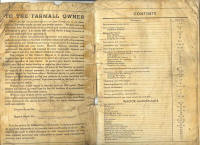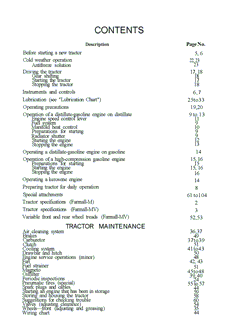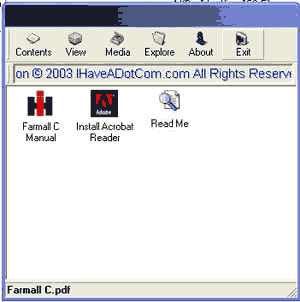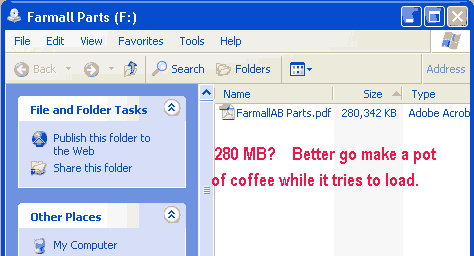 |
The image on the left is a scan showing the
condition one of these manuals was in when we received it.
On the right, is the final results. You can view a larger image by clicking on the thumbnails |
 |
If you own a vintage tractor, there are 3 different manuals you need.
OWNERS MANUAL
The owners manual typically contains useful information regarding day-to-day operation and maintenance of your tractor. Tune up specs, capacities, and basic adjustments are normally included. Some vendors will list a owners manual as a "repair" manual or as a "Owners & Parts" manual when in fact they are simply an owners manual. We don't try to mislead buyers by claiming our manuals are anything other than what the really are. Check how many pages they contain. A typical parts manual contains 2-300 pages. How can they offer a "Owners & Parts" manual with only 100 pages?
SERVICE MANUAL
A service manual goes into greater detail and covers more procedures than an owners manual. Torque specs, troubleshooting guides and wiring diagrams can save you hours of frustration.
If you're expecting a manual that holds your hand and tells you step-by-step how to tear into your old tractor, I'm afraid you're out of luck. "Remove bolt A followed by bolt B...." just isn't the way they wrote these manuals. Old tractor manuals are written for the experienced Farmer that's been tearing into things since he was a young boy.
Not all tractors had service manuals issued for them. In this case, the owners manual had mor service information in them to compensate.
Parts Manuals
Parts manuals can be a lifesaver if you're tearing into your old tractor. They typically contain 2-300 pages of exploded diagrams that show how everything goes together. Trying to figure out where all those parts left over from the last time you rebuilt the engine go? Is that a valve guide or a seat spacer? Was there a gasket here when I tore it apart last week? Nothing beats having a drawing in front of you.
The next time you need to hit the parts counter, you wont have to stand there watching while Leon's son, ( who really is a good kid but sure doesn't know the difference between left hand and right hand muffler bearings) tries to find your part on the microfiche. Just print out the page you need and take it with you.
| How My CD Manuals Are Made |
Most manuals are in pretty poor shape when I get them. They've been sitting in a tractor toolbox for years and many pages are torn, grease stained, and mouse nibbled.
 |
The image on the left is a scan showing the
condition one of these manuals was in when we received it.
On the right, is the final results. You can view a larger image by clicking on the thumbnails |
 |
The manuals are first scanned with an OCR program that helps to re-format the faded text, fill in missing letters, and align the images and text. Next, each page goes through photo editing to clean up the blurry images, and remove the greasy fingerprints. Most are then sent to a word processor to correct spelling errors. Finally everything is converted to PDF format. The service and owners manuals have a hyperlinked index for easy access to the pages you need.
The text in most manuals is searchable so you don't need to hunt through all the pages for specific information. Just type in the words you're looking for and you'll get a list of pages that contain those words. Try that with a printed manual!
Unfortunately, the parts manuals are primarily tables of numbers, and pages of illustrations, so I do NOT run them through an OCR program to reformat the text. To do so would introduce countless errors when the OCR software mistakes a number 1 for the letter l.
To access these manuals, simply put the CD in your computer and it will automatically prompt you to either view the manual or install the Acrobat Reader files. It's in PDF format and the index page is hyperlinked so you can click on the information you want and go directly to the correct page. Once you find the information you need, simply print it out, smear it with grease, and throw it away when you're done. Mess up a page? No problem! Just print out another fresh copy and get back to work. This manual will never wear out!

I've purchased CD manuals in the past and have been sorely disappointed with the quality. What I've received ranges from a bunch of blurry, unorganized JPEG files scanned at 100 DPI, to copies of my manuals that have been butchered in order to try and remove the copyrights.
My A&B parts manual is 72 MB. The last thief had no idea what he was doing and made it a 280 MB file that locked up my computer. No auto run software, no help file, and no hyperlinks. Just a huge PDF file that took 3 tries to load. The amazing thing was he got good feedback from most of his buyers! Ebay shut him down permanently and unfortunately his buyers are left with no recourse.

| Printed Manuals |
My printed manuals are the same high quality
as the CD versions. They are not a cheap, 4'th generation photo copy done one
a copy machine. They're professionally printed on 24 lb paper, unused, and the
text is crisp. The binding allows it to stay open even when it's laying on the
hood of your tractor. If you prefer a used manual, we will smear some grease on
the cover and dog-ear a few pages for a slight additional charge.
![]()
Question; What's the difference between a "Operators" manual and a "Owners" manual?
Answer; My memory.![]() I list the printed version as an Operators manual and the CD as a Owners Manual
so I can keep track of which one was sold. When I correspond with a buyer or get
ready to ship, I can determine the which version was sold just from the title.
I list the printed version as an Operators manual and the CD as a Owners Manual
so I can keep track of which one was sold. When I correspond with a buyer or get
ready to ship, I can determine the which version was sold just from the title.
As you might guess, I've spent many hours cleaning up the original manuals and reformatting them in a professional, easy to use format. If you're thinking about copying this manual for resale, think about this. I've imbedded watermarks and font changes through-out the pages. Some are visible, and some aren't.
I buy manuals with several different IDs and look for copies of MY work. When I buy my manual that someone has copied, I vigorously pursue the seller. If you resell my manuals, please keep good records because I will be asking for them.